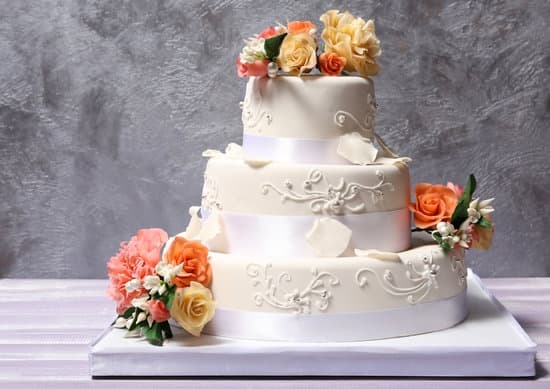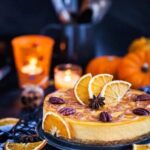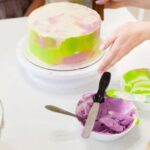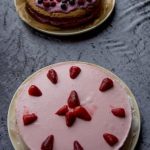When it comes to creating visually appealing desserts, easy cake decorations play a crucial role in adding that extra touch of elegance and charm. Whether you’re a baking enthusiast or simply looking to impress your guests, knowing how to decorate a cake can take your dessert game to the next level. From simple buttercream techniques to elaborate fondant designs, there are endless possibilities for decorating cakes that cater to every skill level.
With the right tools and materials at your disposal, you can easily elevate the presentation of your cakes and turn them into works of art. From piping bags and tips to fondant molds and edible flowers, having these essential items on hand will make the process of decorating a cake much more manageable and enjoyable. Whether you’re a beginner or a seasoned baker, mastering the art of cake decoration is sure to make any occasion sweeter and more memorable.
In this article, we will explore various cake decoration techniques, from simple buttercream designs to more complex fondant creations. We’ll also delve into creative ideas for using edible flowers and plants as decorations, as well as techniques for making impressive chocolate decorations.
Whether you’re looking for quick and easy ideas or seeking to challenge yourself with advanced techniques, this comprehensive guide will inspire you to get creative in the kitchen and create show-stopping desserts that are not only delicious but also visually stunning.
Essential Tools and Materials
Decorating a cake can be a fun and rewarding experience, but having the right tools and materials is essential to create beautiful and professional-looking designs. Whether you are a beginner or a seasoned baker, having the necessary equipment will make the process of decorating cakes much easier and more enjoyable. Here is a comprehensive list of essential tools and materials needed for easy cake decorations.
One of the most important tools for cake decoration is a turntable, which allows you to easily rotate the cake as you work on it. This makes it easier to apply frosting evenly and smoothly. Piping bags and tips are also crucial for creating intricate designs with buttercream or royal icing. Additionally, an offset spatula is essential for spreading frosting and smoothing out surfaces.
When it comes to materials, having a good quality fondant is key for creating smooth and flawless decorations. Food coloring gels or powders will allow you to customize the colors of your decorations. Edible glitter, sprinkles, and edible pearls are great for adding sparkle and texture to your cakes. With these essential tools and materials in hand, you’ll be well-equipped to create stunning and professional-looking cake decorations.
| Tools | Materials |
|---|---|
| Turntable | Fondant |
| Piping bags | Food coloring gels/powders |
| Piping tips | Edible glitter/sprinkles/pearls |
Simple Buttercream Techniques
Buttercream frosting is a versatile and delicious option for decorating cakes. It is easy to work with and can be used in various ways to create stunning designs. Whether you are a beginner or an experienced baker, mastering buttercream techniques can take your cake decorations to the next level.
Basic Buttercream Piping Techniques
One of the simplest and most popular ways to decorate cakes with buttercream is through piping techniques. To start, make sure you have the right piping tips – start with a round tip for outlining and filling, a star tip for rosettes or borders, and a petal tip for creating flower petals. Practice your pressure control by squeezing the piping bag gently to release the frosting smoothly.
Creating Textured Designs
To add dimension to your cake decorations, try using different textured designs with buttercream. You can create ruffles by using a petal tip in a back-and-forth motion, or add texture with a grass tip for a fun and unique look. Experiment with different piping tips and techniques to find what works best for your design ideas.
Colorful Buttercream Creations
Don’t be afraid to play with colors when working with buttercream. You can easily tint your frosting with gel food coloring to create vibrant designs on your cakes. Use multiple colors in one piping bag for multi-colored effects, or try ombre techniques by blending two or more shades together on the cake. The possibilities are endless when it comes to easy cake decorations with colorful buttercream.
Fondant Basics
Fondant is a versatile and popular choice for cake decorators due to its smooth finish and ability to be molded into various shapes. Working with fondant may seem daunting at first, but with practice and the right techniques, anyone can create stunning cake decorations.
To begin working with fondant, you will need a few essential tools and materials. A good quality rolling pin, powdered sugar for dusting, a sharp knife or pizza cutter for cutting shapes, and vegetable shortening to prevent sticking are just a few of the items you will need. Additionally, having a fondant smoother on hand can help achieve that flawless finish on your cakes.
When it comes to shaping fondant, one important tip is to knead it well before rolling it out. This helps soften the fondant and make it more pliable for shaping onto your cake. To prevent drying out, always keep extra fondant covered when not in use. With some practice and patience, you’ll soon be creating beautiful fondant decorations for your cakes.
One easy cake decoration idea using fondant is to create simple cut-out shapes like hearts, stars, or flowers to place on top of your cakes. You can also layer different colors of fondant to create a marbled effect for a visually striking design. The possibilities are endless when working with fondant, so don’t be afraid to get creative and experiment with different techniques.
| Tools | Instructions |
|---|---|
| Rolling Pin | Knead the fondant well before rolling it out |
| Powdered Sugar | Dust the surface with powdered sugar before rolling out the fondant |
| Sharp Knife or Pizza Cutter | Use these tools to cut shapes or trim excess fondant from your decorations |
Edible Flowers and Plants
Choosing the Right Flowers
When selecting edible flowers for decorating cakes, it is crucial to choose ones that are safe for consumption. Make sure to use organic or pesticide-free flowers that have not been treated with chemicals. Popular choices include pansies, roses, violets, lavender, chamomile, and nasturtiums. Additionally, ensure that the flowers are thoroughly washed and dried before using them on your cake.
Placement and Arrangement
Once you have chosen your edible flowers, consider how you want to arrange them on your cake. You can place individual petals strategically around the edges of the cake for a delicate touch or create a cascading effect by layering larger blooms on top of each other. Edible flowers can also be used to create intricate floral designs or patterns on the surface of the cake.
Preservation Techniques
To ensure that your edible flowers stay fresh and vibrant on your cake, you can use preservation techniques such as crystallizing or candying them. Crystallized flowers are coated in sugar syrup and left to dry until they form a sparkling finish that can last for days. Candied flowers involve dipping fresh blooms in egg whites and laying them out to dry, resulting in a glossy sheen that preserves their beauty for longer periods.
These preserved edible flowers can be used as stunning decorations for special occasions or events where you want your cake to stand out visually. Incorporating edible flowers and plants into your cake decorations adds a whimsical touch that is sure to impress your guests while also adding delightful flavors to your dessert creation.
Chocolate Decorations
Creating chocolate decorations for your cakes is a surefire way to impress your guests and elevate the visual appeal of your desserts. Whether it’s delicate curls, artistic drizzles, or intricate molds, chocolate can add a touch of elegance and sophistication to any cake. With the right techniques and a little practice, you can easily master the art of chocolate decorations.
To get started with making impressive chocolate decorations, you will need a few essential tools and materials. Here is a list to help you gather everything you need before diving into the world of chocolate decorating:
- High-quality chocolate (dark, milk, or white)
- Parchment paper or silicone mats
- A heatproof bowl
- A spatula for stirring
- A piping bag or plastic squeeze bottle
- A microwave or double boiler for melting the chocolate
One of the easiest ways to create stunning chocolate decorations is by making chocolate curls. Simply melt your desired type of chocolate, spread it thinly on parchment paper, let it set slightly, then use a sharp knife or bench scraper to create beautiful curls.
You can also create decorative drizzles by melting chocolate and piping it onto your cake in artistic patterns. For more advanced decorations, you can try using molds to shape the melted chocolate into intricate designs before setting them on top of your cake.
With these simple techniques and a bit of creativity, you can easily take your cake decorating skills to the next level with stunning and delicious chocolate decorations that will impress everyone at your next gathering. Let your imagination run wild as you experiment with different shapes, colors, and textures to create one-of-a-kind masterpieces that are as delightful to look at as they are to eat.
Quick and Easy Ideas
Decorating a cake doesn’t have to be a daunting task, especially for beginners. There are plenty of quick and easy ideas that can elevate your dessert and impress your guests. Whether you’re short on time or just starting out in the world of cake decorating, these simple techniques can make a big impact. Here are some easy cake decoration ideas that anyone can do:
- Use fresh fruit: Adding fresh fruit to your cake not only adds a pop of color but also provides a refreshing contrast to the sweetness of the dessert. Simply place slices of strawberries, kiwis, or blueberries on top of your frosted cake for a beautiful presentation.
- Sprinkle decorations: Sprinkles are an easy way to add a festive touch to any cake. Whether you choose colorful jimmies, sparkly sugar crystals, or shimmering nonpareils, simply sprinkle them over your frosted cake for a fun and whimsical look.
- Stencil designs: Stenciling is a simple yet effective way to create intricate designs on your cakes. Using a stencil and powdered sugar or cocoa powder, gently dust the design onto the surface of your cake for a professional-looking finish.
These easy cake decorations not only require minimal effort but also yield impressive results. With just a few basic tools and materials, you can transform any plain cake into a stunning masterpiece. The key is to keep it simple and let your creativity shine through. Don’t be afraid to experiment with different techniques and find what works best for you.
Advanced Techniques
As you continue to hone your cake decorating skills, the world of advanced techniques opens up a whole new realm of possibilities. From elaborate sugar flowers to intricate piping designs, mastering these advanced skills can truly elevate your desserts to a professional level. While it may seem daunting at first, with practice and patience, you can achieve stunning results that will wow your friends and family.
One advanced technique that is sure to impress is sugar sculpting. This intricate art form involves creating detailed sculptures from sugar paste or gum paste. Whether you’re crafting delicate figurines or ornate decorations, sugar sculpting allows you to add a personalized touch to your cakes like never before. With the right tools and a steady hand, the possibilities are endless.
Additionally, exploring the world of isomalt can take your cake decorations to the next level. Isomalt is a type of sugar substitute that can be melted down and molded into various shapes and designs. From sparkling gems to delicate lace-like structures, isomalt decorations add a touch of elegance and sophistication to any dessert. With just a bit of practice, you can create show-stopping accents that will leave your guests in awe.
In conclusion, delving into advanced cake decoration techniques allows you to push the boundaries of your creativity and skill set. Whether you choose to master sugar sculpting or experiment with isomalt, these techniques offer endless opportunities for artistic expression. Remember, practice makes perfect, so don’t be afraid to try new things and challenge yourself. With dedication and perseverance, you’ll soon be creating breathtaking works of edible art that will leave everyone amazed.
Frequently Asked Questions
How to Decorate Cake in Home Simple?
Decorating a cake at home can be made simple by using basic techniques such as frosting the cake smoothly, adding a border along the edges, and using sprinkles or edible decorations for extra flair. You can also use tools like piping bags and tips to create different designs on the cake.
How Do You Make a Simple Cake Look Fancy?
To make a simple cake look fancy, you can elevate its appearance by using fresh fruits, edible flowers, or decorative chocolate shavings on top. Adding layers to the cake with frosting in between each one can also give it a more visually appealing look. Another option is to use colored frostings and piping techniques to create intricate designs.
What Type of Cake Is Easiest to Decorate?
The type of cake that is easiest to decorate would be a sheet cake or round cake with smooth sides, such as a classic butter cake or sponge cake. These types of cakes provide a flat surface for decorating, making it easier to add frosting, decorations, and designs without any intricate shapes or angles to work around.
Additionally, these cakes are versatile and can be customized with various flavors and fillings to suit your preferences.

Welcome to our cake decorating blog! My name is Destiny Flores, and I am the proud owner of a cake decorating business named Cake Karma. Our mission is to provide delicious, beautiful cakes for all occasions. We specialize in creating custom cakes that are tailored specifically to each customer’s individual needs and tastes.





